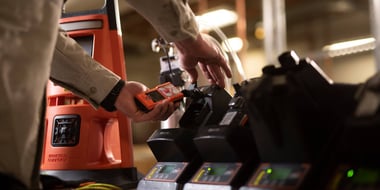Key Takeaways:
- Combining leading and lagging indicators provides a comprehensive view of safety performance and improvement opportunities.
- Real-time data provides immediate insights into current conditions, transforming reactive safety approaches into proactive ones.
- Connected safety solutions make data actionable by integrating monitoring technology and analytics to enhance situational awareness and EHS outcomes.
 Data is used throughout various points of daily operation. It's needed to track performance, gauge trends, to focus attention on specific issues, and even to educate or inspire our workforce. Regardless of the current situation, it’s critical to focus on the right data points that are specific and are relevant to our goals.
Data is used throughout various points of daily operation. It's needed to track performance, gauge trends, to focus attention on specific issues, and even to educate or inspire our workforce. Regardless of the current situation, it’s critical to focus on the right data points that are specific and are relevant to our goals.
Digging Into Data
Data is typically bucketed into two categories: quantitative—temperature, weight, concentration—and qualitative—color, texture, smell. Measuring data using either bucket is important to any safety management process. These data points help measure leading vs. lagging indicators.
Lagging Indicator – the traditional Safety and Health metrics used to indicate progress toward the number and/or severity of events that have occurred, typically output oriented.
Leading Indicator – proactive, preventative and predictive metrics that provide current information about the effectiveness or performance of a Safety and Health management system, typically input oriented.
In the context of gas detection, lagging indicators help safety teams explain events, incidents, and problems in the past. Leading indicator, on the other hand, help teams explore hypotheses and opportunities for improvement, ultimately influencing the future of their safety protocol.
So between these two, which should safety managers seek to employ in a safety management system?
The answer is both.
Using lagging and leading indicators together will help provide a bigger picture of what is and is not working in your EHS program. Every organization's workplace is unique, so it's important to look at which indicators will provide you with the best information.
A 2013 study indicated that when incorporating leading indicators into their lagging indicators:
- 70% of EHS representatives stated their programs were either very successful in its current form or were working well and had the ability to improve.
- 64% of respondents of the survey claimed a higher than anticipated impact from using both leading and lagging indicators when compared to other reporting requirements.
The Importance of Real-Time Data
Sitting between the historic-minded lagging indicators and the future-focused leading indicators lies the information of the present: real-time data.
Real-time data is delivered immediately after its collection and provides a snapshot of worker conditions, behaviors, and events.
Real time data integration into safety management systems transforms reactive safety approaches into proactive ones by providing immediate insights into unsafe conditions and worker behaviors. For example, connected devices such as gas detectors, environmental sensors, and wearable technology can instantly identify and report hazard conditions like gas leaks, high temperatures, or unsafe noise levels.
This holistic view enhances situational awareness, enabling faster and more informed decision-making during emergencies or daily operations.
Putting Data to Work with Connected Safety Solutions
Industrial Scientific’s connected safety solutions are designed to help organizations harness the full spectrum of data to build smarter, more proactive safety programs. By integrating advanced gas monitors, real-time monitoring, and cloud-based analytics, safety teams gain the insights they need to respond faster, prevent incidents, and continuously improve their EHS performance.
Whether you're looking to enhance situational awareness or drive long-term safety outcomes, our solutions make data actionable.
Learn more about our solutions and the importance of data in connected safety by downloading our guide, The Power of Connected Safety.



